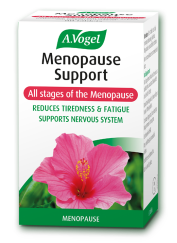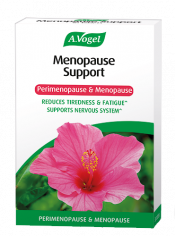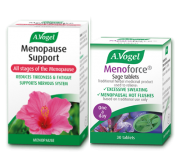Read the full video transcript below
Today's topic
Hello and welcome to my weekly video blog. And today on A.Vogel Talks Menopause, I'm going to be discussing water retention. Now, this is such a common symptom in the menopause and so many of you have emailed me and at some point have said, "Help. What can I do about this?"
How water retention affects your body
Now, the main area that it tends to affect are under the eyes. You can get really puffy eyes and you can get the dark circles under the eyes. It can affect the breasts. It can affect the fingers and the ankles. And also if you had water retention problems whilst you were menstruating, if this was one of your maybe PMT symptoms, this very often follows you through to the menopause as well.
What causes water retention?
Now, why on Earth does this happen? Well, it's really quite simple. Falling oestrogen as we know affects the nervous system and it affects two glands that kind of control the nervous system called the adrenals. And one of the other things that the adrenals do is that they control the hormones that deal with our water balance.
So if our nervous system gets really stressed, that can affect the way in which the body holds on to water. Now, what really happens here is that dehydration, believe it or not, is behind this. When you are dehydrated, the body goes into a panic because we need a lot of water.
Seventy-five percent of our body, at least, is made of water and we need huge amounts for everything to take place properly in the body. So if we start to lose the ability to hold on to water, the body goes into a panic, and it will hold on to every single bit of moisture that it can and these areas that I mentioned before are ones where it's quite easy for the body to do that.
And unfortunately, in this situation when we tend to maybe think we might get a little waterlogged or bloated, we tend to think, well, it must be because we're drinking too much water, and we often drink less. And this, of course, will make the symptoms worse.
What you can do to reduce water retention during menopause
1. Avoid becoming dehydrated
So this is really important as I'm always saying, "Water, water, water, loads of it." And you would be surprised at how quickly your water retention problems will disappear if you start to drink lots of water. And again, with lots of water, the puffiness under the eyes can go, the dark circles can disappear.
You might find that any sort of stiffness and discomfort in the hands disappear as well. Your joint aches can ease off too. And your skin can look such a lot better if you remember to drink plenty of water. And very often, it's really quite interesting in that hot flushes and night sweats often go together with water retention and it's just because the sweats and the flushes are causing extra dehydration.
So it's really important, again if you're getting flushes and sweats, to drink plenty of water. And I find it really rewarding, so many women will contact me and say, "All I've done is just add in a little bit more water into my daily diet and my symptoms have got so much better." So this is something if you're new to the weekly video blogs and you're just getting into the menopause, water is so very, very important.
And another really good sign that maybe you're struggling with water is that your kidneys can sometimes complain and this, you can get just a very dull ache each side of your lower spine. So that may be an indication too that you're just needing to up your water intake.
And remember tea, and coffee, and fizzy drinks, and fruit juices do not count towards your water intake. It really needs to be plain still water if you can do that. But I've written quite a number of blogs on water, so you can follow one of these links if you want a little bit more information for that as well.
2. Watch your salt intake
The other thing that can cause water retention is too much salt. And we know that, you know, today you're only supposed to take a little bit of salt on a daily basis and a lot of you do say, "But I don't add salt to my cooking." But salt is everywhere. You know, it's in the usual things we know, things like crisps, and processed foods, and ready meals have lots of salt.
But it can be in things like your daily breakfast cereal. It's in lots of bread, it's in biscuits. It's in things that you wouldn't even really think salt should be in there. So it's really important to look at everything that you're buying and check where salt is on the list of ingredients. If it's really high up the list, then that's something that you should maybe try to avoid.
The other thing to look at is the type of salt that you are using. And most of us tend to use white salt, table salt. Table salt is refined, it's had absolutely everything stripped of it. Your natural mineral salt such as your sea salt, your Himalayan salt, your unrefined salts have other nice ingredients in them and they tend to be different colours as well.
So look for the colour of salt and try to avoid white table salt because this really isn't good for you at all. Also look at the foods that you're eating. There's a whole range of lovely foods that can help you with the water retention and salt balance too, which I'll speak about in a minute.
3. Get your lymphatic system moving
The other thing that can happen too is a sluggish lymphatic system. Now, your lymphatic system is a bit like the blood circulation but it doesn't have a pump. It doesn't have the heart to pump water and fluid round the body. So if you sit for a long time, or if you stand for a long time, the lymphatic system basically shuts down and that especially can cause water retention round the ankles.
Now, if you're anything like me, I do spend quite a lot of time sitting at my desk when I'm in the office and it can be very difficult to move. So I've now bought myself a little timer, set it for an hour, and after every hour when it beeps, I get up, and I do a quick run round the building. I'm on the first floor, so I can do a really brisk walk.
I run down the stairs. I walk all the way round the bottom and then run back up the stairs again. And that's sometimes just enough to get your lymphatic system working again. If you can't get away from your desk, or you really can't do any quick form of exercise, then even just pumping your legs up and down for a little while and rotating your ankles, will get things moving too.
So it's really important, if you're suffering from water retention to get some kind of exercise in on a daily basis if you can.
4. Eat the right foods
Now, looking at the foods that are really helpful for all of this, there's loads of them and they tend to be all the wonderful fresh foods that you can get. So we're looking at dark green leafy vegetables, we're looking at nuts, we're looking at seeds, things like broccoli and leeks.
We're looking at brown rice, avocados, blackcurrants, oily fish, and also eggs too. So make sure that you have plenty of these foods in your daily diet and that can help as well.
5. Try some herb teas
If you're looking for herb teas, if you're wanting maybe a little bit of a quick fix for something, then you can look at teas such as nettle tea.
You can look at fennel tea and we also do a lovely kidney support tea that can be helpful for this as well called Golden Rod & Knotgrass Tea.
So as you see, there are lots of things that you can do for the water retention. One little word of warning though, if you're really having serious problems with swollen ankles, if they're starting to get red, if they're starting to get really painful, if you have them all the time, then please do go and see your doctor as this could be one of the signs of high blood pressure.
So, you know, just take care on that score. So hope you enjoyed this, and I look forward to seeing you next week on A.Vogel Talks Menopause.









